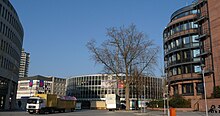Berliner Platz (Ludwigshafen)
The Berliner Platz is a central place at the south end of downtown Ludwigshafen . It is the central hub of local public transport.
history
From 1890, the Ludwigshafen-Brücke station of the meter-gauge local railway was located at this point .
On the occasion of the city's 50th anniversary in 1903, the Jubilee Square in the form of a park was laid out in the triangle between the two ramps leading to the Rhine Bridge and Ludwigstrasse; At that time, Ludwigstrasse merged directly into Mundenheimer Strasse. At the same time, the electric tram was led from Mannheim over the Rhine Bridge to Ludwigshafen and the local train station was enlarged (the tram and the local steam train shared the tracks in Ludwigsstraße [today's pedestrian zone]). In 1928 the station building was demolished, the railway facilities reduced and the Pfalzbau built there. On the west side, Ludwigstrasse was built on with a continuous row of houses; this was also broken through in 1928 from Bismarckstrasse. Jubiläumsstraße, today the southern part of Bismarckstraße, was continued through Jubiläumsplatz to the southern bridge ramp, so that the park was largely built up. In 1930 the Tietz department store was built on the southern corner of Jubiläumsstrasse and Ludwigstrasse . In the summer of 1932, the local railway between Mundenheim and the city center was stopped. The existing tracks were upgraded for the electric tram and the provisional station barracks built in 1928 were demolished. In 1939 the entire block of houses in the triangle Ludwigstr./Wredestr./Jubiläumsstr. demolished to have a place in front of the entrance of the palace building. In 1952 the Ankerhof was opened on this open space. As part of the business card project , the entire area was completely redesigned in 1959 through the reconstruction of the Rhine bridge and the first section of the elevated road to the west (today A 650 ); the northern of the two ramps to the Rhine bridge was demolished and in 1960 a Kaufhof branch opened in the so-called cake box ; Shortly afterwards, the only 30-year-old Tietz department store was demolished, as was the Pfalzbau, which was provisionally restored after the war. Today's palace building was opened elsewhere in 1965. Since then, the tram and bus stop has been called "Berliner Platz" (previously: "Pfalzbau"). The square was given its current design in 2003 when the RheinNeckar S-Bahn and the new Ludwigshafen-Mitte stop were opened .
The position of the tram tracks from the pedestrian zone to Bleichstrasse and the arched course of the house front on the northern edge of Berliner Platz in the course of the bridge ramp built in 1867 have not changed since around 1900; however, there is no longer a pre-war building in the area of the square. The architecture of the cake box that was built later took up the existing structural conditions.
In 2015 the cake box on Berliner Platz was torn down. All buses and trams had to be rerouted for this. By October 2015, the demolition work was largely complete.
Development
Berliner Platz is surrounded by several round buildings:

|
The Faktorhaus , an office and commercial building through which the tram lines to Mannheim run |

|
Residential buildings and an office building. The arched course indicates the course of the access to the Rhine bridge before 1959. |

|
In addition, there is direct access to the newly built Ludwigshafen-Mitte S-Bahn station and the Walzmühle shopping center, as well as the partially newly laid out Rhine promenade. |
Conversation II
In the middle of Berliner Platz, the kinetic sculpture Conversation II by the American artist George Rickey is located above a granite plinth filled with water . The work of art is a present from BASF to the citizens of Ludwigshafen on the occasion of the turn of the millennium.
On a slender stele, two L-shaped elements are set in a rotating motion by air movement, which results in either the letter L or U, together the license plate for Ludwigshafen: LU.
public events
Berliner Platz is also the location for central public events. The annual Christmas market takes place here. In the warm season, every second Wednesday at 7.30 p.m. is the meeting point for the Skatenight Ludwigshafen.
safety
In order to curb the consequences of massive alcohol consumption by young people during the night, the city of Ludwigshafen obtained approval from the Ministry of the Interior of Rhineland-Palatinate in the summer of 2008 to set up a prohibited alcohol zone on the square. At this point there were massive problems with nightly brawls and complaints about noise pollution.
The alcohol ban comes into force in April and ends in September. The city council decided this unanimously, but the local advisory council wanted a permanent alcohol ban, but the supervisory authority only approved a six-month hazard prevention ordinance. After the regulation expired in autumn 2008, the number of incidents increased again. Almost half of all incidents are due to excessive alcohol consumption. Over 80 percent of the physical injuries were recorded between midnight and 7 a.m. Disco visitors are particularly noticeable, as there are three large discos within 500 meters of Berliner Platz.
literature
- Marlis Jonas (photos); Richard W. Gassen (text): “ KunstRaum Stadt. Public Art in Ludwigshafen am Rhein ”. Heidelberg: Kehrer Verlag, 2007.
supporting documents
Web links
- »How should one behave on Berliner Platz?« Performance series of the FH Ludwigshafen on the question of the perception and design of public space in the city (head: Andrea Lutz-Kluge)
Coordinates: 49 ° 28 '47.3 " N , 8 ° 27' 5.1" E

